CARTOXP三维电生理标测系统介绍
- 格式:ppt
- 大小:1.40 MB
- 文档页数:20
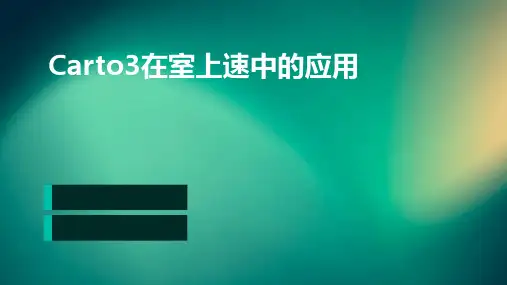

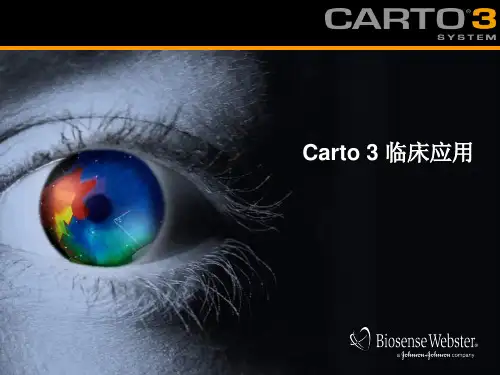
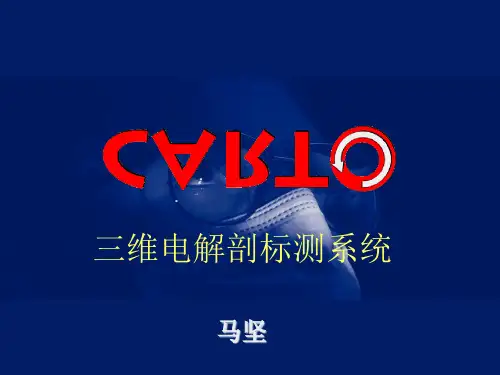
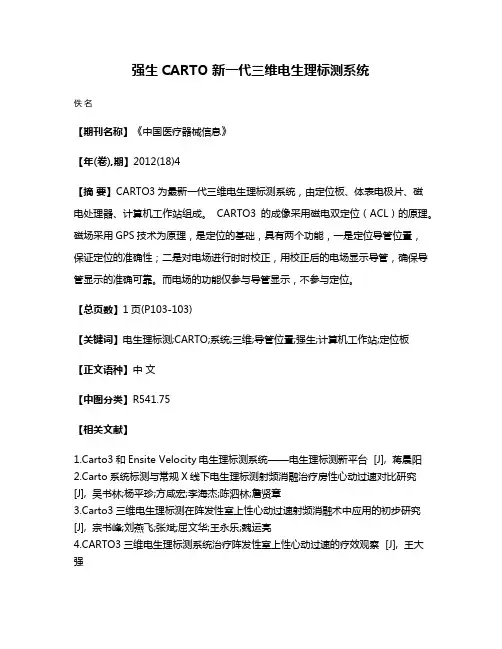
强生CARTO 新一代三维电生理标测系统
佚名
【期刊名称】《中国医疗器械信息》
【年(卷),期】2012(18)4
【摘要】CARTO3为最新一代三维电生理标测系统,由定位板、体表电极片、磁电处理器、计算机工作站组成。
CARTO3的成像采用磁电双定位(ACL)的原理。
磁场采用GPS技术为原理,是定位的基础,具有两个功能,一是定位导管位置,
保证定位的准确性;二是对电场进行时时校正,用校正后的电场显示导管,确保导管显示的准确可靠。
而电场的功能仅参与导管显示,不参与定位。
【总页数】1页(P103-103)
【关键词】电生理标测;CARTO;系统;三维;导管位置;强生;计算机工作站;定位板
【正文语种】中文
【中图分类】R541.75
【相关文献】
1.Carto3和Ensite Velocity电生理标测系统——电生理标测新平台 [J], 蒋晨阳
2.Carto系统标测与常规X线下电生理标测射频消融治疗房性心动过速对比研究[J], 吴书林;杨平珍;方咸宏;李海杰;陈泗林;詹贤章
3.Carto3三维电生理标测在阵发性室上性心动过速射频消融术中应用的初步研究[J], 宗书峰;刘燕飞;张斌;屈文华;王永乐;魏运亮
4.CARTO3三维电生理标测系统治疗阵发性室上性心动过速的疗效观察 [J], 王大强
5.CARTO3三维电生理标测系统治疗阵发性室上性心动过速的疗效观察 [J], 王大强
因版权原因,仅展示原文概要,查看原文内容请购买。
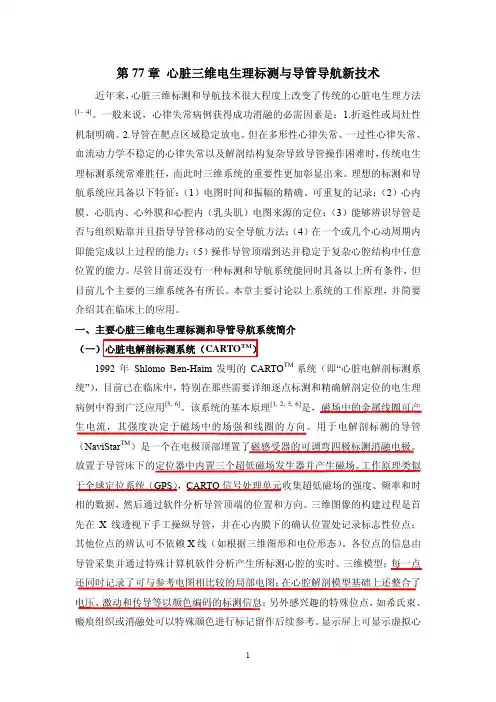
第77章心脏三维电生理标测与导管导航新技术近年来,心脏三维标测和导航技术很大程度上改变了传统的心脏电生理方法[1- 4]。
一般来说,心律失常病例获得成功消融的必需因素是:1.折返性或局灶性机制明确。
2.导管在靶点区域稳定放电。
但在多形性心律失常、一过性心律失常、血流动力学不稳定的心律失常以及解剖结构复杂导致导管操作困难时,传统电生理标测系统常难胜任,而此时三维系统的重要性更加彰显出来。
理想的标测和导航系统应具备以下特征:(1)电图时间和振幅的精确、可重复的记录;(2)心内膜、心肌内、心外膜和心腔内(乳头肌)电图来源的定位;(3)能够辨识导管是否与组织贴靠并且指导导管移动的安全导航方法;(4)在一个或几个心动周期内即能完成以上过程的能力;(5)操作导管顶端到达并稳定于复杂心腔结构中任意位置的能力。
尽管目前还没有一种标测和导航系统能同时具备以上所有条件,但目前几个主要的三维系统各有所长。
本章主要讨论以上系统的工作原理,并简要介绍其在临床上的应用。
一、主要心脏三维电生理标测和导管导航系统简介(一)心脏电解剖标测系统(CARTO TM)1992年 Shlomo Ben-Haim发明的CARTO TM系统(即“心脏电解剖标测系统”),目前已在临床中,特别在那些需要详细逐点标测和精确解剖定位的电生理病例中得到广泛应用[5, 6]。
该系统的基本原理[1, 2, 5, 6]是,磁场中的金属线圈可产生电流,其强度决定于磁场中的场强和线圈的方向。
用于电解剖标测的导管(NaviStar TM)是一个在电极顶部埋置了磁感受器的可调弯四极标测消融电极。
放置于导管床下的定位器中内置三个超低磁场发生器并产生磁场。
工作原理类似于全球定位系统(GPS),CARTO信号处理单元收集超低磁场的强度、频率和时相的数据,然后通过软件分析导管顶端的位置和方向。
三维图像的构建过程是首先在X线透视下手工操纵导管,并在心内膜下的确认位置处记录标志性位点;其他位点的辨认可不依赖X线(如根据三维图形和电位形态)。
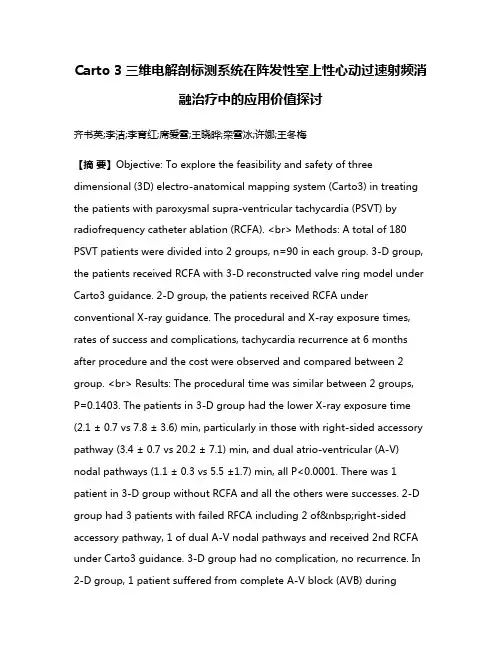
Carto 3三维电解剖标测系统在阵发性室上性心动过速射频消融治疗中的应用价值探讨齐书英;李洁;李育红;席爱雪;王晓晔;栾雪冰;许娜;王冬梅【摘要】Objective: To explore the feasibility and safety of three dimensional (3D) electro-anatomical mapping system (Carto3) in treating the patients with paroxysmal supra-ventricular tachycardia (PSVT) by radiofrequency catheter ablation (RCFA). <br> Methods: A total of 180 PSVT patients were divided into 2 groups, n=90 in each group. 3-D group, the patients received RCFA with 3-D reconstructed valve ring model under Carto3 guidance. 2-D group, the patients received RCFA under conventional X-ray guidance. The procedural and X-ray exposure times, rates of success and complications, tachycardia recurrence at 6 months after procedure and the cost were observed and compared between 2 group. <br> Results: The procedural time was similar between 2 groups, P=0.1403. The patients in 3-D group had the lower X-ray exposure time (2.1 ± 0.7 vs 7.8 ± 3.6) min, particularly in those with right-sided accessory pathway (3.4 ± 0.7 vs 20.2 ± 7.1) min, and dual atrio-ventricular (A-V) nodal pathways (1.1 ± 0.3 vs 5.5 ±1.7) min, all P<0.0001. There was 1 patient in 3-D group without RCFA and all the others were successes. 2-D group had 3 patients with failed RFCA including 2 of right-sided accessory pathway, 1 of dual A-V nodal pathways and received 2nd RCFA under Carto3 guidance. 3-D group had no complication, no recurrence. In 2-D group, 1 patient suffered from complete A-V block (AVB) duringablation and 1-year later, the Holter showed II° to III° AVB;2 patients with recurrence including 1 of dual A-V nodal pathways and had successful 2nd ablation. The cost was higher in 3-D treatment. <br> Conclusion: RFCAwas feasible for treating PSVT patients under Carto3 guidance, which had the higher success rate with lower X-ray exposure and complication.%目的:探讨三维电解剖标测系统(Carto3系统)指导下阵发性室上性心动过速(阵发性室上速)射频消融的可行性及安全性。
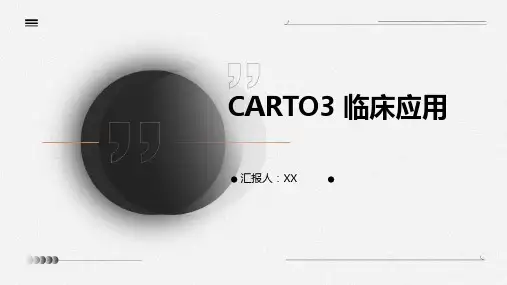
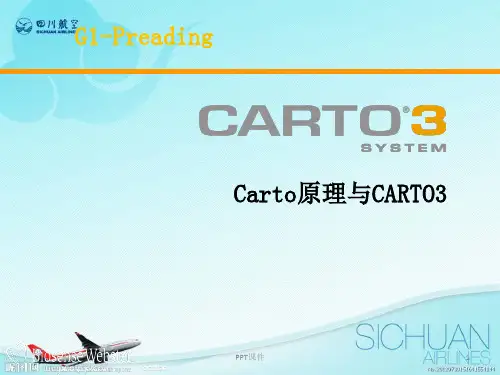


CARTO3三维标测系统快速解剖建模在阵发性心房颤动射频消融术中的应用田野;杨龙;郑亚西;刘晓桥;刘志琴;范寿年;殷跃辉【摘要】Objective: To investigate the safety and efficacy of CARTO3 fast anatomical mapping during radiofrequency ablation in patients with paroxysmal atrial ifbrillation (PAF). Methods: A total of 120 PAF patients treated in our hospital from 2013-01 to 2015-07 were enrolled. All patients received CARTO3 system for mapping and they were randomly divided into 2 groups: Control group, the patients had selective pulmonary vein angiography, followed by conventional point by point method to reconstruct left atrial model for guiding the ablation of PFA and Treatment group, the patients had selective pulmonary vein angiography followed by fast anatomical mapping to build left atrial model for guiding the ablation of PFA; the rest operational steps such as trans-septal and circumferential pulmonary vein ablation were the same.n=60 in each group. The times of operation, X-ray exposure and the rates of success, complication occurrence were compared between 2 groups. Results: All patients were successfully completed radiofrequency ablation for PAF. Compared with Control group, Treatment group had increased modeling time (8.5 ± 3.6) min vs (5.2 ± 2.3) min, while decreased pulmonary vein ostium determing time (12.0 ± 5.6) min vs (25.0 ± 8.4) min, circumferential pulmonary vein ablation time (95.0 ± 22.0) min vs (115.0 ± 25.0) min and X-ray exposure time (15.0 ± 6.3) min vs (24.0 ±5.5) min, allP<0.05. The rates of success andcomplication occurrence were similar between 2 groups, P>0.05. Conclusion: CARTO3 fast anatomical mapping is safe and effective for guiding radiofrequency ablation in PAF patients, it may decrease the X-ray exposure time and operation time which were important for treating the relevant patients.%目的:探讨CARTO3三维标测系统快速解剖建模在阵发性心房颤动(房颤)射频消融术中的安全性及有效性。